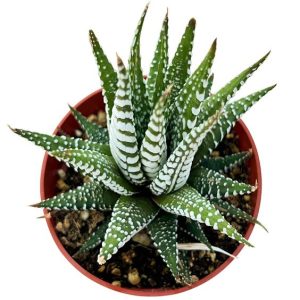Haworthia Zebra

- Botanical Name: Haworthiopsis attenuata
- Family Name: Asphodelaceae
- Stems: 4-6 inchs
- Temperature: 18 – 26°C
- Other: light-loving, frost-resistant
Overview
Product Description
Haworthia Zebra, also known as the striped twelve-roll or zebra plant, is a small succulent plant famous for the white stripes on its leaves. Here is a detailed introduction to Haworthia Zebra:
Morphological Characteristics
The leaves of Haworthia Zebra are triangular, pointed, dark green, and covered with white stripes or bumps. These stripes not only add to the plant’s aesthetic appeal but also enhance its texture. The leaves grow outward from the center in a rosette pattern. Mature rosettes typically reach a height of 8-12 inches (20-30 cm) and can spread to about 12 inches (30 cm) wide.

Haworthia Zebra
Growth Habit
Haworthia Zebra is a perennial succulent with a clumping growth habit. It often produces small offsets at the base that can take root and become mature plants on their own. This growth pattern allows it to spread outwards, creating a carpet of rosettes in its natural habitat and in cultivation.
Suitable Scenarios
Haworthia Zebra is highly suitable as an indoor decorative plant. Its small size and unique appearance make it a popular choice for desk plants, windowsills, or succulent arrangements. Additionally, this plant is generally non-toxic to pets and humans, making it a safe choice for households with animals.
Haworthia Zebra, also known as the zebra haworthia, is a small succulent plant renowned for the white stripes on its leaves.
Spring is one of the growing seasons for Haworthia Zebra. During this season, the plant requires more water, but it is still essential to avoid overwatering. Water the plant when the soil surface is dry, typically every two weeks. Spring is also a good time to fertilize, using a fertilizer suitable for succulents diluted according to the package instructions.
Summer is the peak growing period for Haworthia Zebra, and it requires ample light. Place the plant in a location with bright, indirect light, avoiding the intense direct sunlight in the afternoon, which can cause sunburn on the leaves. If the plant is outdoors, it may need some shade during the hottest part of the day. Additionally, regular watering is necessary in the summer, but ensure that the soil is completely dry before watering.
As fall approaches and the weather cools, the growth rate of Haworthia Zebra will gradually slow down. At this time, you should gradually reduce the frequency of watering to help the plant adapt to the dry conditions of winter. Fall is also an appropriate time to move outdoor plants indoors, especially before frost sets in, to prevent the plant from frost damage.
During winter, the growth of Haworthia Zebra almost comes to a halt, and it requires minimal water. At this time, you should significantly reduce watering, and you can go for several months without watering, only considering it when the soil is completely dry. The plant should be placed in an indoor environment where the temperature does not drop below 10°C, avoiding cold windows or doorways. Additionally, winter is not the season for fertilizing, so it should be avoided.










